Overheating can be a serious problem in horses. More often this is an issue in summer with warm, humid weather; yet it can occur at all times of the year. As in any species, overweight horses are more prone to overheating. Any sort of breeze, even those supplied artificially with fans can help to cool your equine friends due to convection cooling with sweating and the subsequent heat loss during drying.
To determine if your horse is at risk for overheating monitor your horses’ basic health parameters such as rate of breathing, rectal temperature, capillary refill time and attitude.
- Start with their breathing by observing their abdomen rise and fall. Increased respiratory rate is normal after exercise and should decrease within a few minutes of activity stopping. If your horse continues to breathe heavily, this may be of concern.
- Taking a temperature rectally with a thermometer is also useful. A thermometer from your local pharmacy is adequate. Temperatures elevated above 102.5 F after cool down or at rest if out on pasture, justifies a call to your veterinarian.
- Overall attitude can relay how a horse is feeling. An overheating horse may be uninterested in their surroundings, hanging their head, or not willing to eat grass or feed that’s offered.
- Capillary refill time is checked by pressing a finger against the gums or gingiva above the front incisor teeth to cause the color to fade and return. Normal color should be light pink to pink. After the gingiva is pressed color should return in less than 2-3 seconds. Also take note of how much moisture is present when touching your horse’s gums, as tacky or dry gingiva can relate to dehydration.
To cool an overheating horse, start with hosing them off with cool water. Avoid using ice cold water as this may be a shock to your equine companion. After a cool bath, be sure to remove the excess water from his or her coat using your hand or a sweat scraper. This water can trap heat and act in an insulating fashion, rather than continuing to cool their temperature. Place your horse in a shaded area with a cool breeze or fan to continue the cooling process. Always offer free choice, fresh, cool water for drinking. After exercise small drinks of water are preferred during cool down.
Sweating is the natural way for horses to cool body temperature down. Along with loss of water, horses loose important electrolytes in their sweat. These electrolytes are minerals such as potassium, chloride, sodium and smaller amounts of calcium, and magnesium. Working horses or those that are sweating in hot weather can benefit from electrolyte supplementation even if they have a mineral block available. Options for supplementation include regular salt (sodium chloride) or light salt (potassium chloride) added to grain, water, or offered free choice. No more than 2 tablespoons per day should be added to grain for a full sized horse. If electrolyte water is offered, regular water should be available at all times as well. Horses that are used to salt blocks and licks should be gradually transitioned to loose salt over 1-2 weeks to prevent over consumption. Another option is top dressed electrolyte mixes (Doctor’s Choice-Recharge is offered at Lodi Veterinary Care) or oral pastes such as Electro-plex can be given.
If your horse does not show signs of sweating during conditions where they would normally be expected to, he/she may have a more severe condition occurring called anhidrosis. We urge you and your pets to stay cool during this summer’s heat wave. Please do not hesitate to call should questions arise.

